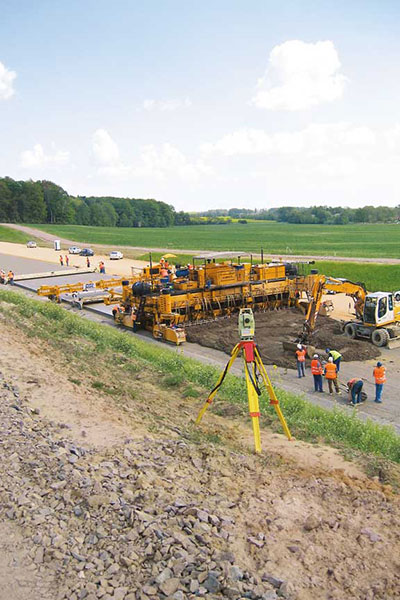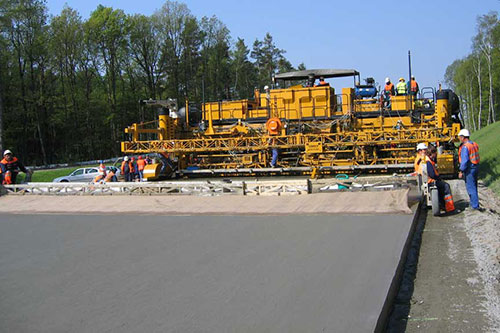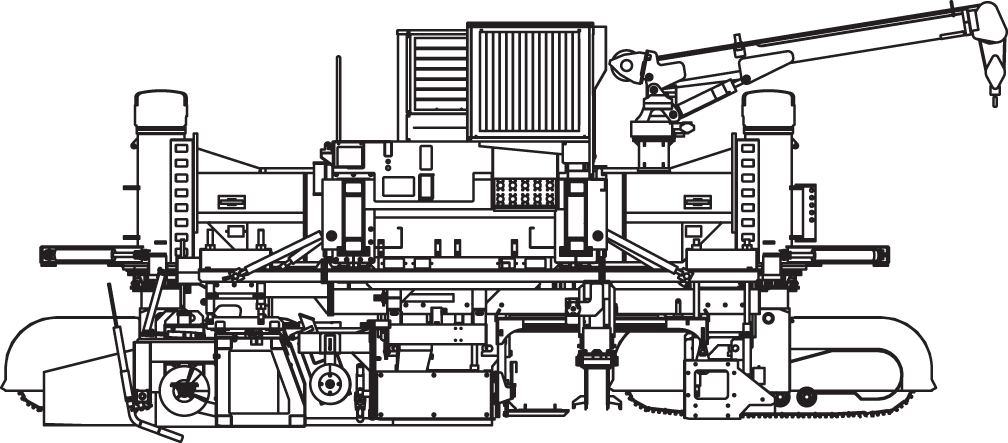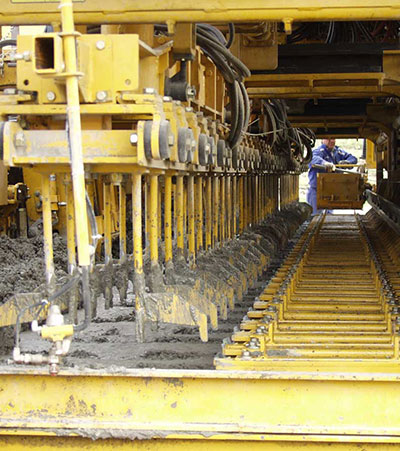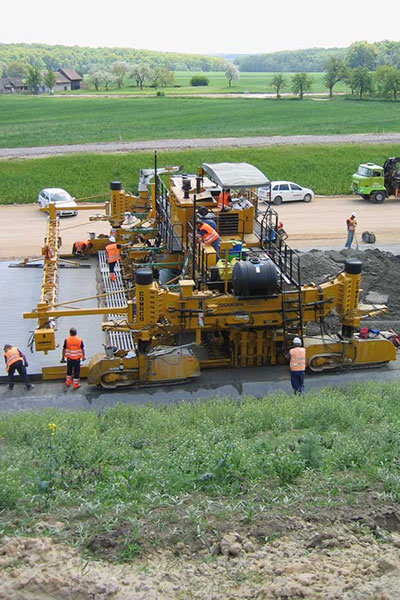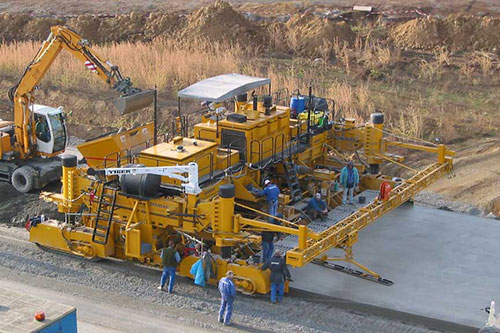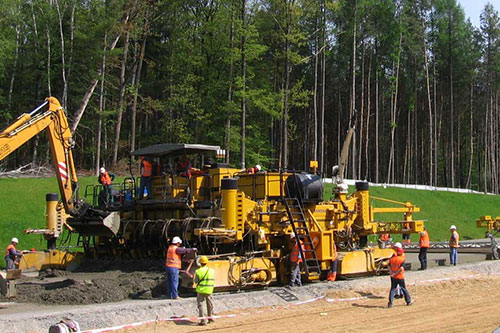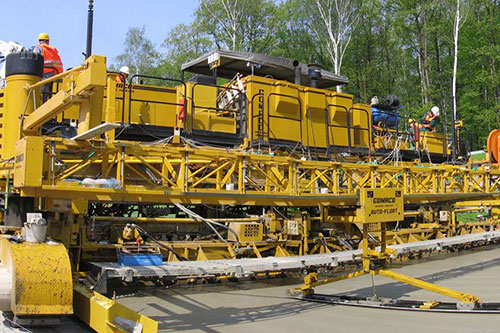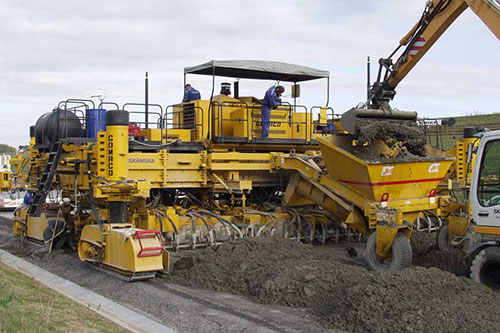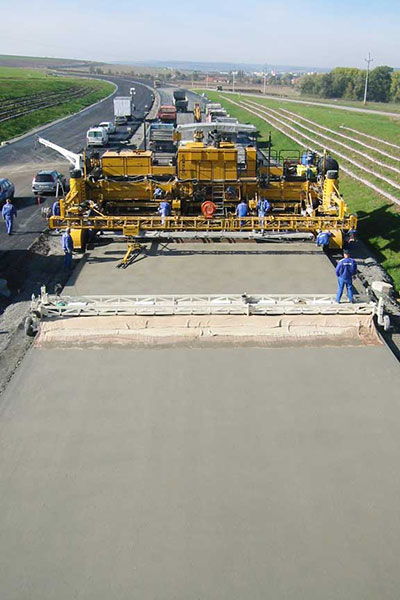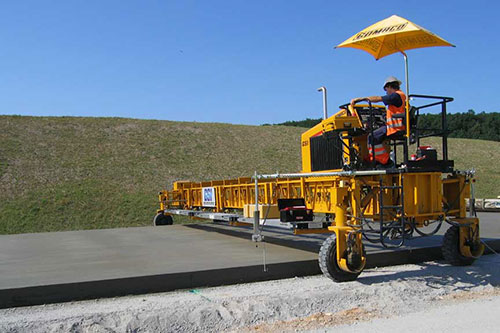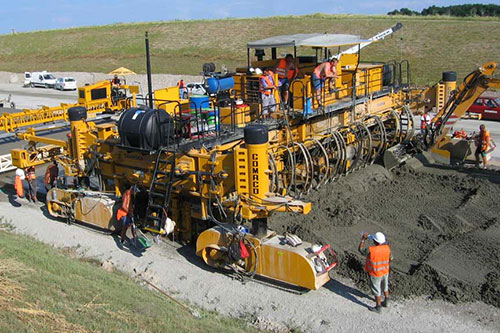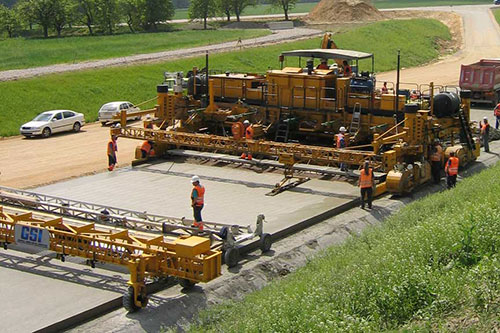GOMACO World Index --- GOMACO World 35.2 - July 2007
Introducing a New Slipforming System to the Czech Republic
The Czech Republic is undertaking a massive road-building effort to improve the quality of the country’s roadways. Several different projects are underway that will improve traveling conditions for local citizens, truckers and tourists.
Skanska DS a.s., based out of Brno, Czech Republic, has been at work on two of those major road-building projects, one on Highway D1 near Vyskov, and a second on Highway D11 near Hradec Králové. They’ll be slipform paving a total of 58 km (36 mi) of new roadway by the time both projects are completed.
The Czech Republic also specifies two-lift pavement on some of their projects, or a roadway made up of two layers and two different concrete mix designs. It was a requirement on Skanska’s first project, Highway D1. The typical method for two-layer pavement in the country requires two separate machines. A paver leads laying down the first layer of concrete, a placer/spreader follows spreading out the second concrete mix and a second paver follows behind paving the top layer of concrete with a mid-mount dowel bar insertion system.
Officials from Skanska had observed that version of two-lift paving and wanted a more efficient way for their project. They began discussions with GOMACO about a GP-4000 paver with a two-lift system incorporated on a single paver.
GOMACO’s two-lift system fits underneath the paver. No extra extensions or paving machines are needed. It was a concept that intrigued Skanska, and they ultimately purchased a GP-4000 with the two-lift paving system for the Highway D1 project. The paver is also equipped with an In-the-Pan Dowel Bar Inserter (IDBI) and Leica stringless control system.
Highway D1: Praha–Ostrava
The new section of Highway D1 runs between Vyskov and Morice, and involved building 16 km (9.9 mi) of two-lane roadway. Specifications on the project called for a 200 mm (7.9 in) thick bottom layer with a 100 mm (3.9 in) thick top layer for a total thickness of 300 mm (11.8 in).
"The two layers are a general requirement for this highway," Josef Richter, Production/Technical Manager of Skanska, said. "The difference between the two concrete mix designs is mostly the size and quality of the aggregate. The upper layer has a maximum aggregate size of 22 mm (0.9 in), while the bottom has a maximum of 32 mm (1.25 in).
"The mix contains both air entrainment and plasticizers. Aeration is the basic requirement for frost resistance and to resist against chemical sanding."
One concrete batch plant was used for both concrete mix designs. Concrete was mixed at a 2:1 batching ratio, with two loads of the bottom concrete mix batched versus just one of the thinner top layer.
Concrete was hauled to the paving site by dump trucks with a hauling capacity of 25 tons. Trucks dumped directly onto the grade for the bottom layer or lift of the roadway. Augers on the front paving pan spread the material, vibration is applied consolidating the bottom layer and the second mold finishes the top layer of concrete.
An excavator running in front of the paver emptied concrete out of the trucks for the top layer. The excavator places the concrete into a specially designed hopper on the front of the GP-4000 paver. The concrete is conveyed from the hopper into a top-layer paving chamber and is spread with an auger across the width of the pavement. The vibrators in the top layer paving chamber run parallel to the face of the paving pan. Their placement ensures the top layer of concrete is properly consolidated without mixing it into the bottom layer of concrete and changing both mix designs. Vibrators placed along the width of the pan provide proper consolidation to the edge.
The two layers are slipformed simultaneously underneath the length of the paver. The arrangement guarantees a good bond between the two layers because of the freshness of the two layers of concrete.
The IDBI is attached to the paver behind the second pan and inserts bars for the joints in the new roadway. Forty bars with a 25 mm (1 in) diameter and 500 mm (19.7 in) length were inserted every six meters (19.7 ft) across the width of the pavement. The bars were placed 250 mm (9.8 in) apart and 150 mm (5.9 in) deep into the slab.
"The bar placement accuracy was perfect," Richter said. "Checks were conducted to test the accuracy of the placement and the tests showed good results every time."
Paving widths varied between 10.75 meters (35.3 ft) and 12.25 meters (40.2 ft) depending on project specifications. Producing the two different mix designs from a single plant with double drums limited their daily production, which averaged approximately 400 meters (1312 ft) per day.
Highway D11: Praha–Hradec Králové
Skanska’s second project with their GP-4000 has them at work building 42 km (26 mi) of Highway D11 connecting Hradec Králové to Podûbrady in the Czech Republic. Skanska removed their two-lift paving feature, but left the IDBI on their paver. It was just a matter of removing the first lift or the bottom paving pan of the two-lift system.
Bar insertion requirements are similar to the D1 project. Forty bars are inserted 120 mm (4.7 in) deep into the new roadway every six meters (19.7 ft).
The Leica 3D machine control system is once again at work on the project. Two prisms are mounted on the paver, which are tracked by Leica robotic total stations. The total stations constantly feed machine position coordinates to the 3D controller via a radio link. The paver is also equipped with front and rear slope sensors which measure the machine’s cross slope. The information from the total stations and the slope sensors is used by the 3D controller to calculate final machine position and orientation, and in turn feed control signal information to the main machine controller.
The two-lift paving project near Vyskov required a 200 mm (7.9 in) thick bottom layer with 100 mm (3.9 in) top layer for a total roadway thickness of 300 mm (11.8 in).
Three total stations are at work on the projects. Two are used to guide the paver while the third total station conducts as-built checks behind the paver. The as-built checks measure the line and level of the new concrete roadway and provide instant feedback on the accuracy of the new slab.
The third total station can also be used for leap frogging, which is the process of switching from one total station to the next when one becomes too far away from the paver.
"The system is very modern and an effective method eliminating the human factor influencing the classical ‘stringline guidance’ method," Richter said. "It is very economical and effective and we want to apply it to all of our pavers."
Smoothness of the new roadway is always a concern during the slipforming process. The project specifications required a ride of only 4 mm (0.16 in) per four meters (13.1 ft) on a Planograph testing system. Skanska’s average ride came in under the spec by half. They’re averaging only 2 mm (0.08 in) per four meters (13.1 ft).
This is Skanska’s first project with their new GOMACO Smoothness Indicator® (GSI). The GSI follows directly behind the paver and is constantly monitoring the concrete slab for any bumps that may affect the smoothness. If a bump is detected, Skanska has the option of going back and fixing that bump while the concrete is still in the workable stage.
"It’s definitely helping us achieve a better final smoothness reading because it allows us immediate reaction to any unevenness of the concrete during the slipforming process," Richter said. "We are anticipating eventually using it for measuring our grade to ensure everything is correct before we begin paving."
Skanska continues to slipform new roadway in the Czech Republic with their GOMACO equipment. Slipforming has been a learning process for the company and the clients they work for, but their success is overcoming any skepticism.
"People here are used to different work procedures, concrete formulas, and technologies and this applies not only to Skanska’s managers and employees, but also to people in the investors’ teams, supervisors and engineers," Richter said. "Influencing those initial factors required a lot of effort, enthusiasm of leaders, and gradual steps in promoting the new technical elements and procedures. I am convinced that we have been successful in it and thanks to close cooperation with GOMACO, we are overcoming the natural resistance to new things."
Subscribe to Receive GOMACO World Magazine
